One Day In Liechtenstein
How many people do you know who have ever been to Liechtenstein?
Well, after reading this post, you’ll know at least one!
For those who don’t know, Liechtenstein (or the Principality of Liechtenstein, as it is often times referred to) is the smallest German-speaking country in the world. It is a landlocked micro-state in Western Europe, bordered by Switzerland to the west and south and by Austria to the east. Its area is just over 160 km² (about 61.7 square miles) and it has an estimated population of 35,000. The capital of Liechtenstein is Vaduz… and it was Vaduz that I made plans to visit in late February, 2009.
To start my journey, I boarded a train in Luzern, Switzerland and switched trains in Zurich for a long ride to the eastern edge of the country.
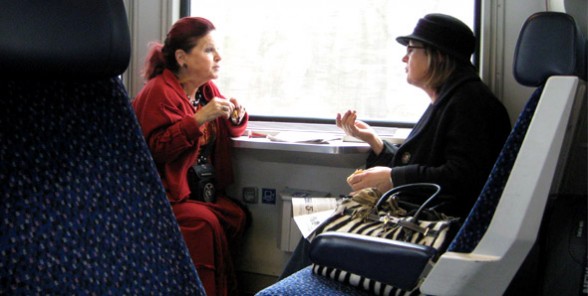
In the city of Buchs I jumped off the train and made my way onto a neon green bus bound for Liechtenstein.
My initial plan was to walk into Liechtenstein on foot, but it was cold that day and my feet were sore. I usually try and avoid public transportation if I can, but the bus was easy to find and the short ride into Liechtenstein was a pleasant one.
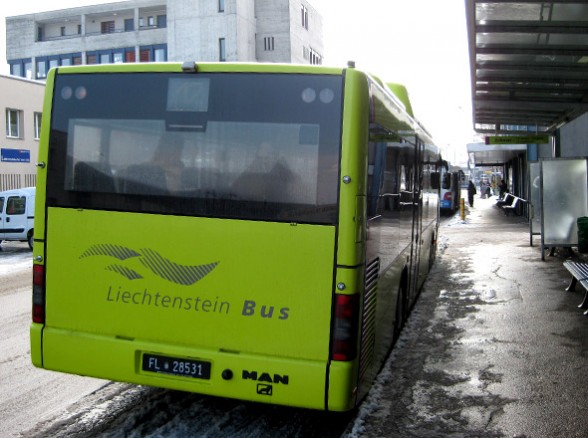
I had expected there to be a border crossing of some kind, but there was no such thing. I don’t recall seeing a sign of any type, nor do I remember seeing a passport shack where I could get my “reisepass” stamped.
After exiting the bus, I found a large wall containing a map of the city and some general information about the town.
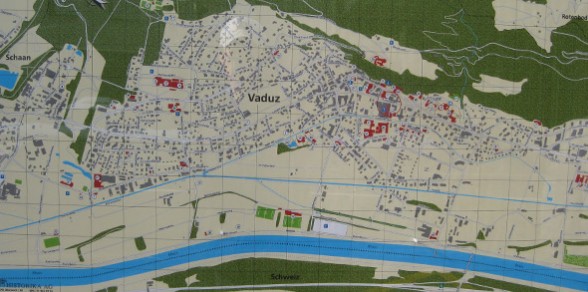

The sign read:
Vaduz is the capital of the Principality of Liechtenstein, residence of the reigning prince and seat of government and parliament. The name “Vaduz” comes from the ancient Latin language and dates back to the time when the Romans ruled over the province of Ratia.
Vaduz was first mentioned in the records in 1150. The county of Vaduz, which now builds the main part of the present principality, was founded in 1342. The castle was once occupied by the following rulers: the Duke of Werdenberg of Vaduz, the Baron of Brandis from Emmental, the Duke of Sulz from Klettau in Badden and the Duke of Hohenems in Vorarlberg.
In the year 1712 Prince Hans Adam of Liechtenstein took over the county of Vaduz and in 1719 Emporer Karl VI united this county with the remaining part of the country, the reign Schellenberg, and called the whole realm the Principality of Liechtenstein. Vaduz was made the capital of this country.
The ancestors of the princes of Liechtenstein belonged to the old Austrian family of noble birth. As generals and diplomats, friends of art and benefactors, they were one of the most respected families in the German and Austrian empires.
Prince Franz Josef II of Liechtenstein was the first member of this family to take permanent residence in the Castle of Vaduz.
The most famous landmark of Vaduz is the castle, the oldest parts of which were build in the 12th Century. Later it was extended several times. The mighty round towers date back to the 16th Century.
The former farming village, especially well-known for its excellent wine, has now developed into a busy town with trade and industry, banks, shops and commercial buildings – the centre of tourism.
It was the Vaduz Castle that I most wanted to see… so that’s where I headed first!

I navigated a short distance through the town and then found an old set of stone stairs that appeared to climb past a few hillside homes and then high up into the mountains.
The path was covered with snow for the most part, but I didn’t let that stop me. I was determined to get to the castle and check it out – even if the paths were covered and I was the only tourist in all of Liechtenstein at the time.
After a short while, I reached a curve in the road and began my ascent toward the Vaduz Castle.
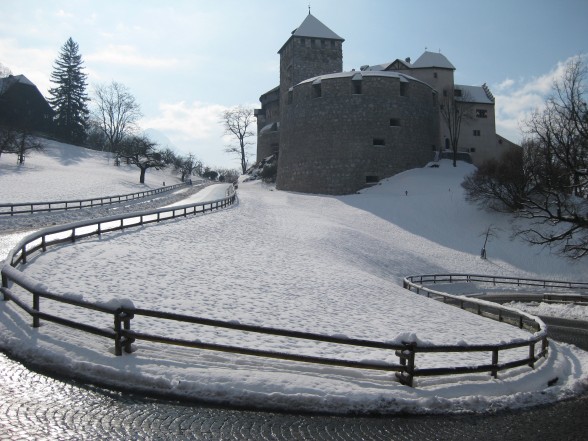

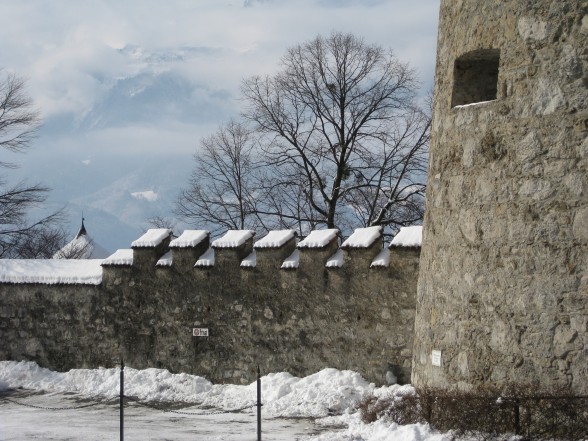
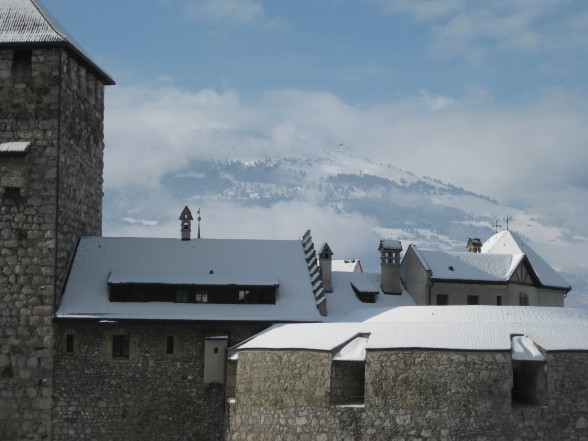
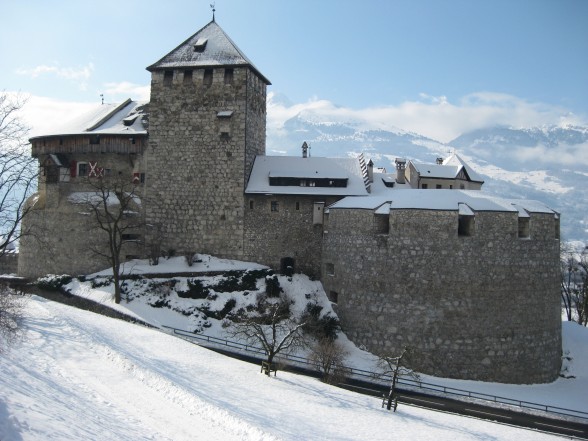
Sadly, I hadn’t done much research in advance and learned only then, once I had reached the entrance to the castle, that they did not let tourists enter. “What a bummer!” I thought to myself.
So, I couldn’t enter the castle and there didn’t appear to be much to see or do in downtown Vaduz, so I decided to continue hiking, up the hillside and into the snow… as high as I could go!

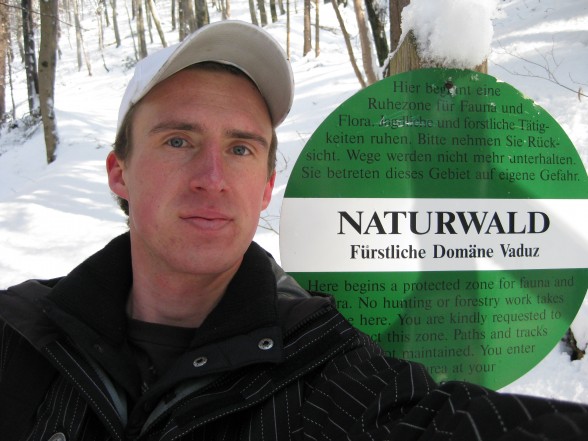
The snow got deeper and deeper the higher I went. I was hiking along a mountain path, but it was obvious that no one had come this way in several week’s time.

After hiking through the trees for a while, I finally emerged in a large, snow-covered opening. The photo below was shot while pointing directly uphill. The mountain peaks, at this point, were completely lost in the clouds.
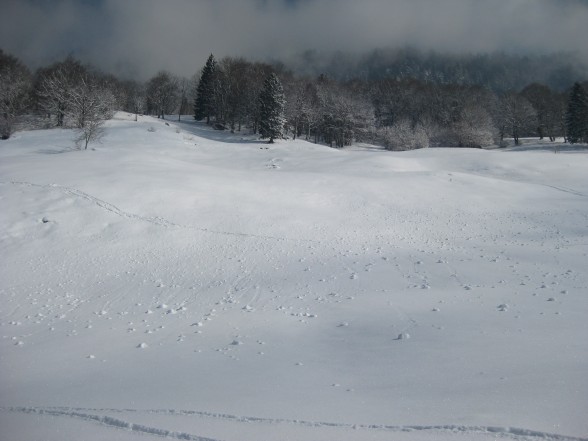
I hiked through deep snow until finally reaching a road containing a number of small homes and outbuildings.
My feet were damp with cold, melted snow and as you can tell by the photos below, by this time in the day I had climbed a considerable distance up the side of the mountain.
I wanted to continue climbing, but I eventually hit a sharp, winding road with little to no shoulder for walking. Because of low-visibility and the speed at which passing cars took the turns, I decided to turn around and descend back down to the city of Vaduz.
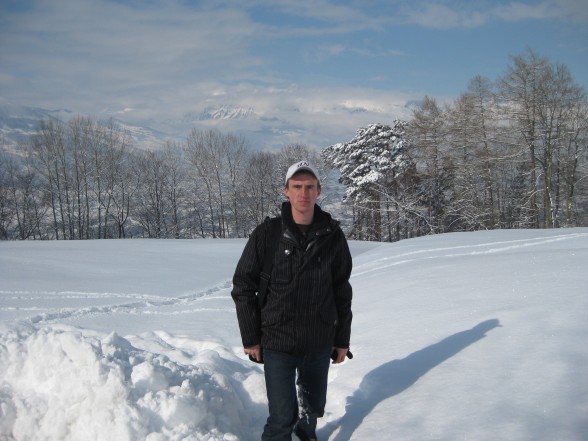
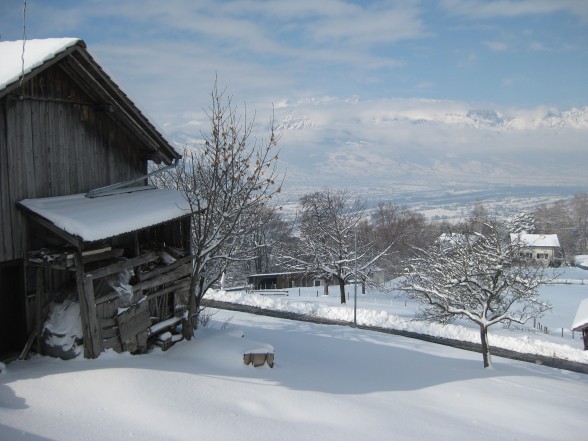
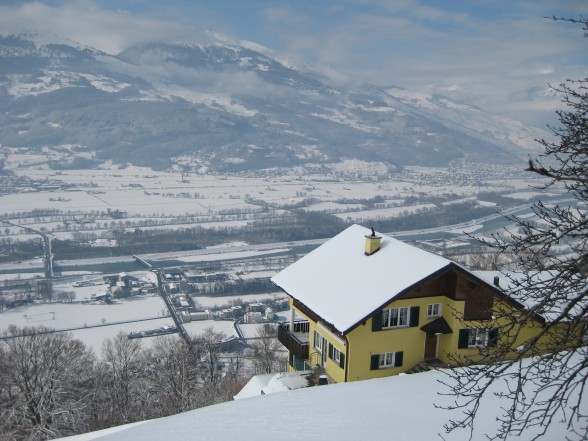
Back in town, there wasn’t much to see or do. I stopped in at a couple tourist shops run by Asian women and looked for a keepsake of some kind, but found nothing that I really wanted.
I visited the tourist office (which was dead silent and managed by a single woman around my age) and had my passport stamped for a fee of 2 Euros. “That’s strange,” I thought to myself. But I was glad to pay the fee and have my passport stamped, as it was something I desperately needed to do now that I had been in Europe for nearly two whole months. I needed proof that I was in fact moving around!

Eventually, I jumped back on the green Liechtenstein bus and took it out of town.
Instead of going back the same way I came, however, and returning to the city of Buchs, I took the bus south for a good half-hour and finally got off in the city of Sargans, Switzerland.
The photos below were taken while traveling through Liechtenstein on the bus.

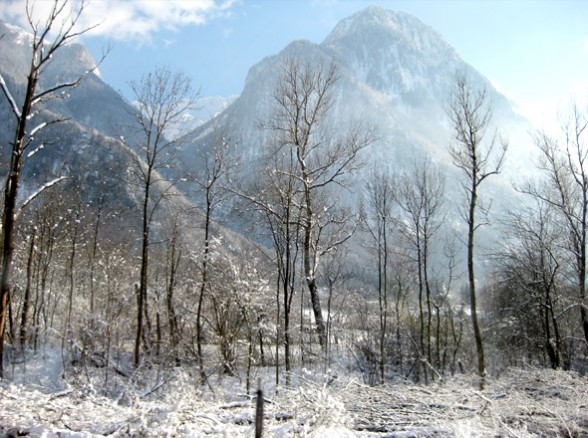
While the mountains of Liechtenstein were majestic and beautiful, the most memorable part of that bus ride back to Switzerland was the man dressed as a clown sitting in the back of the bus, who no one on board seemed to pay any attention to. The other passengers paid no attention to the man and acted as though riding the bus with a clown was an everyday occurrence.
The photo below shows me photographing the clown (who is sitting in the back of the bus, in the upper right-hand corner of the photo, through a reflection in a pane of glass in front of me). I didn’t want to actually turn around and photograph the man, so I tried to be sneaky.

Finally, we crossed back into Switzerland and I exited the bus in Sargans.
The views from the train station were fantastic, but it was freezing cold and I had some time to kill before hopping on my return train back to Luzern, so I went inside to use the restroom and warm up in the neighboring liquor store.
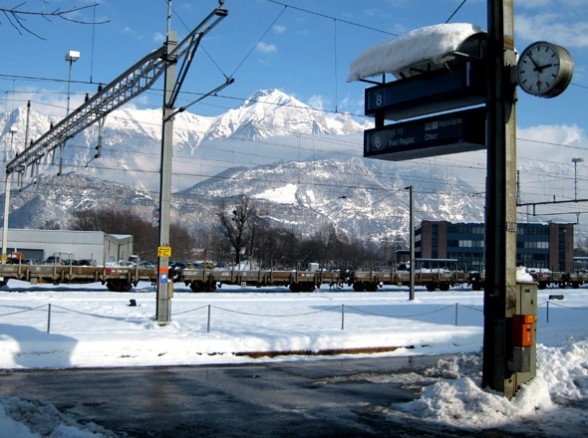
In the bathroom, I was met with a blinding blue light, which filled the entire restroom. I had read about these lights before traveling to Switzerland, but this was the first time I had encountered them.
You see, the Swiss have an interesting way of dealing with their heroin addicts. The Swiss government actually gives heroin users free needles so as to prevent them from obtaining diseases caused by dirty needles. The problem then, is that many of these heroin addicts go into public restrooms in order to shoot up. And to prevent this from happening, business owners often times install blue lights in their restrooms. The blue light makes it so you can’t see your veins… and if you can’t see your veins, you can’t shoot up! Click here to read more about heroin use in Switzerland and to learn more about the way countries like Switzerland and Germany are attempting to help heroin users.
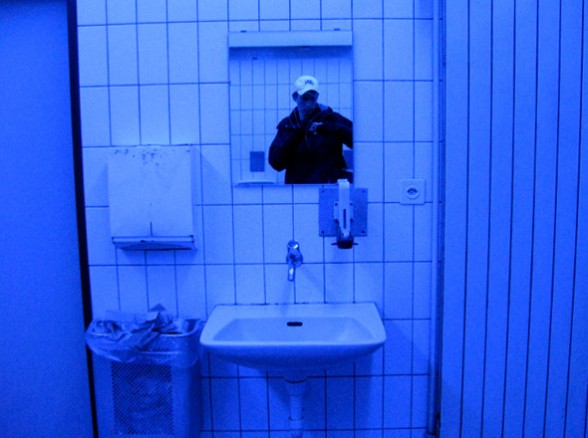

After photographing the blue light urinals, I returned to the train station platform and waited for the “Zug” that would take me back to my home in downtown Luzern.
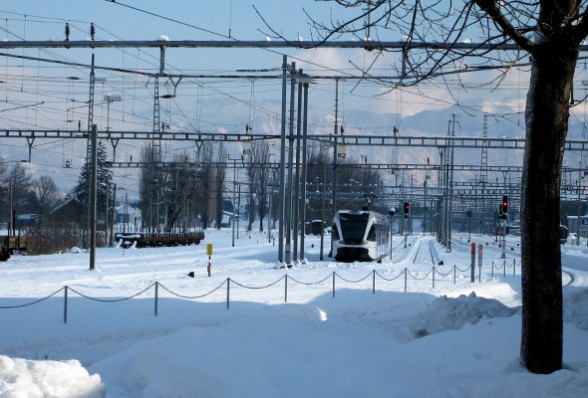
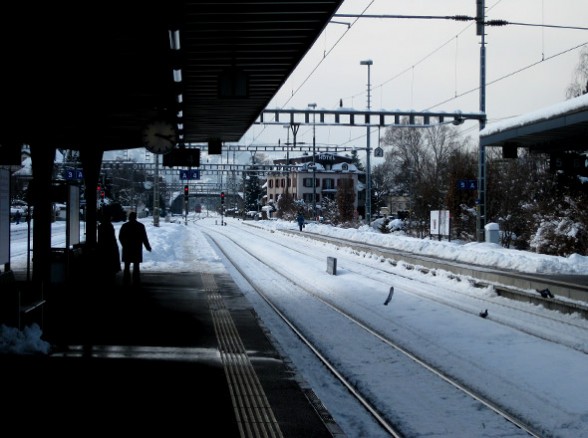
My day in Liechtenstein was a good one and I’d gladly go back if I had the chance.
If you ever have a chance to visit the Principality of Liechtenstein, it is something I would definitely recommend, but I’m not sure I would plan to spend more than a day there. If you go in the summer and you plan to hike or mountain bike, there might be a lot to do. But in the winter, when the land is covered in snow and the town is dead, one day is likely all you need.
Have you ever been to Liechtenstein? If so, what did you think? What should I go back and see/do the next time I am there?

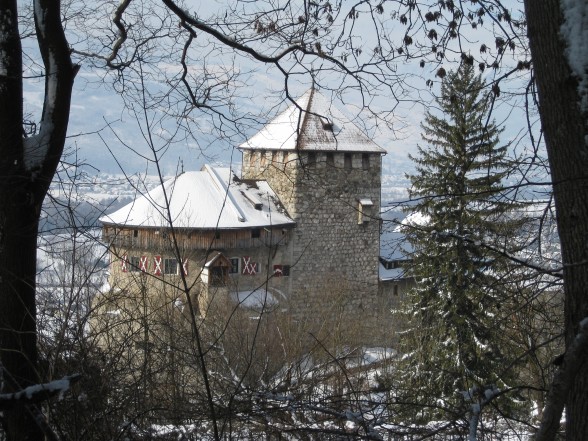
>> How many people do you know who have ever been to Liechtenstein?
Me! I’ve worked, cycled, and hiked there over the years. Did you know Switzerland accidentally invaded in 2007?
https://news.bbc.co.uk/2/hi/6415531.stm
Thanks for sharing all the insight! We are just starting research into visiting and had no idea visitors were not allowed into the castle – very glad to have found out before we got there. Also never heard about the blue light, glad we are prepared for the bathrooms =)